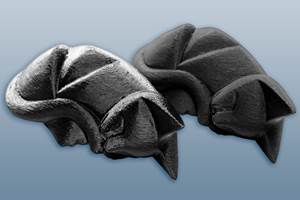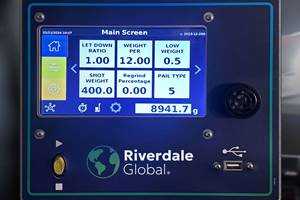Novel ‘Flat’ Fiberglass Enhances Injection Molded TP Composites
Advances in fiberglass reinforcements for thermoplastics have evolved from conventional chopped strand to long-glass fibers to hybrids of long glass and carbon fibers.
Advances in fiberglass reinforcements for thermoplastics have evolved from conventional chopped strand to long-glass fibers to hybrids of long glass and carbon fibers. A key aim is lightweighting while maintaining or enhancing mechanical properties. Key challenges are warpage reduction and ease of processing. Enter a unique family of fiberglass products with a flat rather than round cross-section that may address these issues while offering new benefits.
The new glass comes from Chongqing Polycomp International Corp. (CPIC), Amsterdam, N.Y., Headquartered in Dadukou, China, CPIC is a subsidiary of YTH Group, a global conglomerate of fiberglass, mineral, composites, textiles, financing and trading companies, and is reportedly the world’s third-largest fiberglass manufacturer by installed capacity. CPIC has had U.S. presence since 2012, starting in Rowland Heights, Calif. But in late 2016, the company moved its North American headquarters to the East Coast after acquiring Fiber Glass Industries Inc. (FGI), a 60-year-old privately-held, specialty fiberglass manufacturer in Amsterdam, N.Y. FGI was known for its high level of customer support and rapid deliveries, two features that Zbigniew “Ziggy” Ziobro, former president of FGI and now CPIC’s general manager, aims to continue at CPIC’s North American organization.
Anticipating significant growth in the North American fiberglass market, the company has added several other fiberglass and composites industry veterans to its team. Ziobro noted that the move to its new headquarters puts the customer-service team and management in the same time zone as the majority of the company’s North American customers, which is concentrated in the Midwest and on the East Coast.
ADVANTAGES OF ‘FLAT’ VS. ROUND
The new flat fiberglass is said to facilitate higher fiber loadings and better mechanical properties, including higher impact strength in injection molded thermoplastic composites, while also reducing warpage in thin wall sections.
In addition, the flat glass reportedly enhances thermoplastic processing by providing better fluidity (increased spiral flow), reducing friction, and lowering fiber entanglement and breakage. The flat fibers reportedly tend to flow in planar sheets like mica rather than rolling and tumbling like conventional round glass filaments. In turn, this is said to help provide for a more isotropic dispersion and also allows a higher fiber-volume fraction to be achieved because the fibers pack more closely, as confirmed by scanning-electron micrograph images.
What’s more, the new flat glass products are said to help thwart warpage (differential shrinkage and residual stress relaxation) of a plastic or composite part after demolding. Warpage tends to be a function of non-uniform shrinkage between flow and cross-flow directions of a part, which is particularly exacerbated in high-pressure processes like injection molding. This effect is greater when more fibers line up in the direction of polymer flow than in the cross-flow direction, leading to higher shrinkage and warpage in the cross-flow direction.
Flat fiberglass helps reduce warpage significantly in thin-wall parts because its flow properties differ from those of standard round glass.
In the case of thin-wall parts, the cross-flow (through-thickness) direction represents a smaller proportion of the total thickness vs. skins aligned with resin flow, so the effects of non-uniform shrinkage are more pronounced. To some extent, design and gate placements can help reduce warpage, as can process changes such as lowering speeds of fill and/or packing pressures. However, CPIC’s flat glass is said to help reduce warpage significantly without any other changes, simply by virtue of how the reinforcement fills parts and how it behaves in conjunction with the resin matrix. Moreover, it helps reduce molding pressures and enables the same part to be molded on smaller injection presses with fewer gates.
Glass-filled semi-crystalline resins using this flat fiber have been molded as thin as 1 mm (0.04 in.) without warpage. The flat fibers are said to exhibit excellent bonding and mechanical properties and are recommended for applications in the automotive and electrical/electronic industries. In all other properties, the flat strands are said to be equivalent to conventional round glass fiber of the same type at the same loading.
Initially, the new flat fiberglass reinforcements are being offered in E-glass (ECT) form with filament width of 24 μm (microns) and thickness of 8 μm, or width of 16 μm and thickness of 5.3 μm. Conventional round glass filaments for chopped strands typically range from 10 to 13 μm in diam. The flat strands are subsequently chopped to either 3.0 mm (0.12 in.) or 4.5 mm (0.18 in.), the most common lengths for short-glass injection grades in Europe and North America, respectively.
Three grades of flat glass fiber are offered in both the 1:3 and 1:4 length/width ratios as well as milled forms. The fibers feature unique surface-treatment (sizing) technology for use in nylon, PPA, PBT, PPS and PC resins. Each product may be purchased in either 55-lb paper bags or 2205-lb supersacks.
Related Content
Insight Polymers & Compounding Unveils New Conductive Products Line
The new conductive products line will also be produced for injection molding and extrusion.
Read MoreCalcium Carbonate From Carbon Capture for Brighter Plastics and Greener Steel
CarbonFree is converting steel slag and blast furnace exhaust into an important plastic compounding additive.
Read MoreMasterbatches Reduce Gloss in PLA and PETG 3D Printed Products
Insight Polymers & Compounding’s two low-gloss additive masterbatches shown to boost appearance of 3D printed objects.
Read MoreRiverdale Global Showing Latest Innovations and New Satellite Location in Wisconsin
NPE2024: Live demos of updated RGS controller are among the highlights at its Wisconsin facility that will house the ‘new’ color R&D lab.
Read MoreRead Next
For PLASTICS' CEO Seaholm, NPE to Shine Light on Sustainability Successes
With advocacy, communication and sustainability as three main pillars, Seaholm leads a trade association to NPE that ‘is more active today than we have ever been.’
Read MoreLead the Conversation, Change the Conversation
Coverage of single-use plastics can be both misleading and demoralizing. Here are 10 tips for changing the perception of the plastics industry at your company and in your community.
Read More










